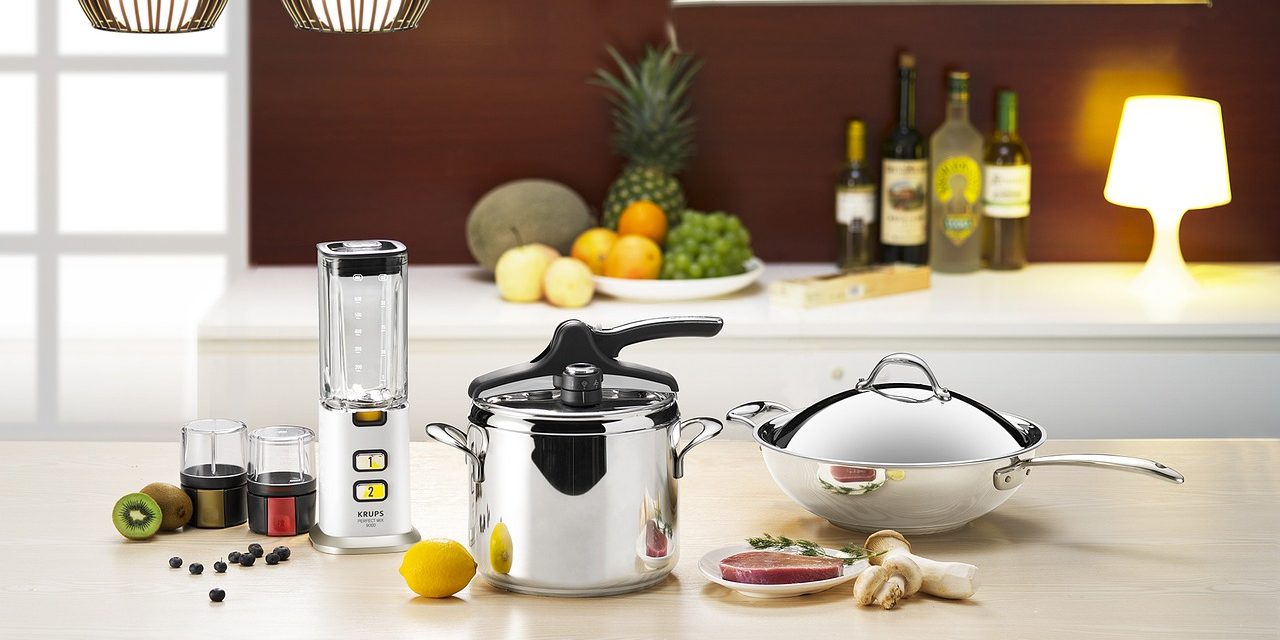Rating of the best track lights for 2020
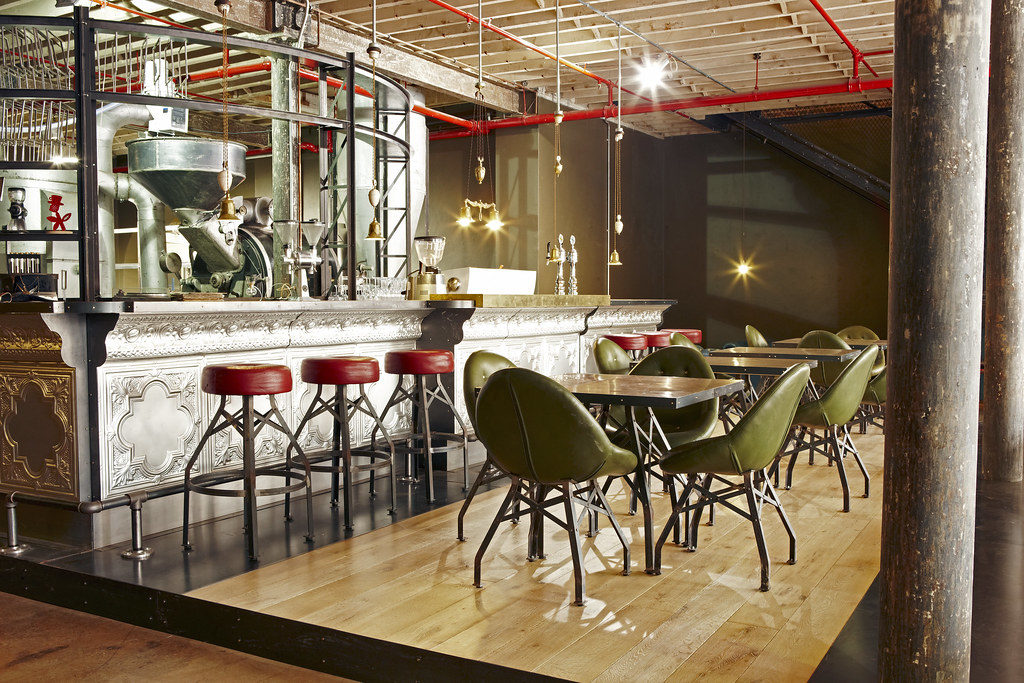
Track lights are the leaders in lighting design. The main difference from other lighting fixtures is the mobility of the bulbs - the spotlights move along the track, change the direction of light (accentuation of the desired object) Analyzing the rating of the best track lights for 2020, you can choose the right lighting option for price, quality, for an apartment or office.
Features:
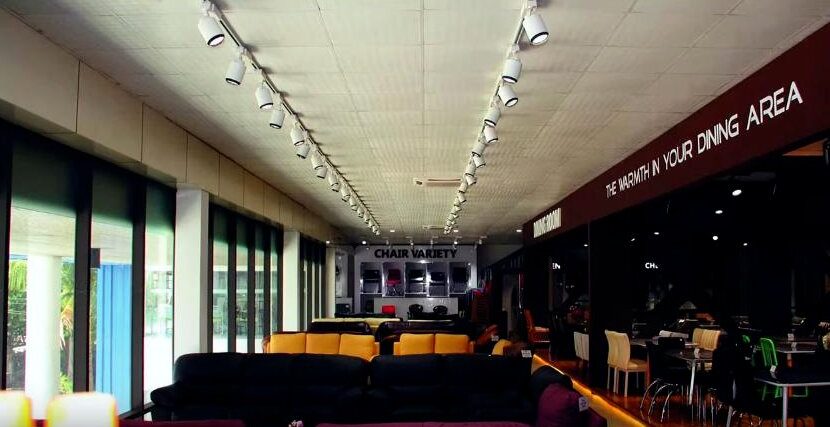
The following advantages are characteristic of track systems:
- easy installation, replacement of individual components;
- modern design;
- maneuverability of lighting devices (along the track, turn of searchlights up to 360⁰);
- minimum power consumption;
- using different bulbs at the same time.
The main disadvantage is the price.
Initially, frame structures were used to illuminate stadiums, warehouses, roads, photo studios, and TV programs. Using the advantages of mobile floodlights, busbar spots, designers began to create new variations of lighting for cafes, restaurants, small apartments, country houses.
Track lighting structures perform the function of lighting, emphasize the style of the restaurant, create a cozy atmosphere of a country house.
How to choose

When choosing a track system, you should pay attention to:
- Installation site: shopping mall, restaurant or apartment.
- Apartment style.
- Select a suitable busbar trunking.
- Choose a light source (take into account technical characteristics, cost, you need a diffuse or local one).
- Study the range of domestic and foreign manufacturers.
- Choose certified products (take into account reviews, recommendations of specialists).
Lighting of apartments
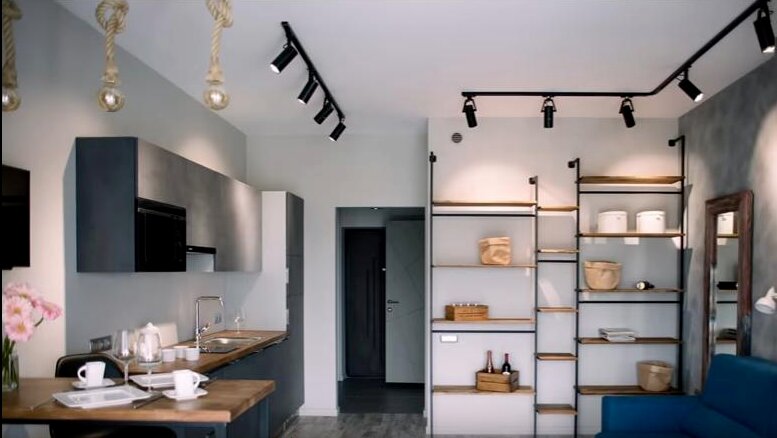
Frame floodlights are used alone or in conjunction with spots. The place of construction will depend on the location of the furniture, the functional purpose of the room:
- recreation areas of living rooms - located around the perimeter of the room, above the chairs, sofas;
- the dining area of the dining room is allocated above the table;
- bedroom - will replace sconces, floor lamps, bedside tables, spots near the dressing table, closet with linen;
- kitchen - installed above the working, dining area, the degree of illumination can be adjusted (when the brightness change function is provided) if the track structures are omitted;
- with the help of directional or accentuated light, they illuminate a small corridor where there are no windows, visually raise the ceiling of the room.
In addition to location, it is worth considering the style of the room:
- Loft or techno styles - spotlights that attract attention will do.
- Minimalism - lanterns are simple in shape, laconic in white or black.
- Hi-tech - devices with a chrome-plated body, unusual design.
- Modern or classic styles - new solutions, light forms.
Structural features
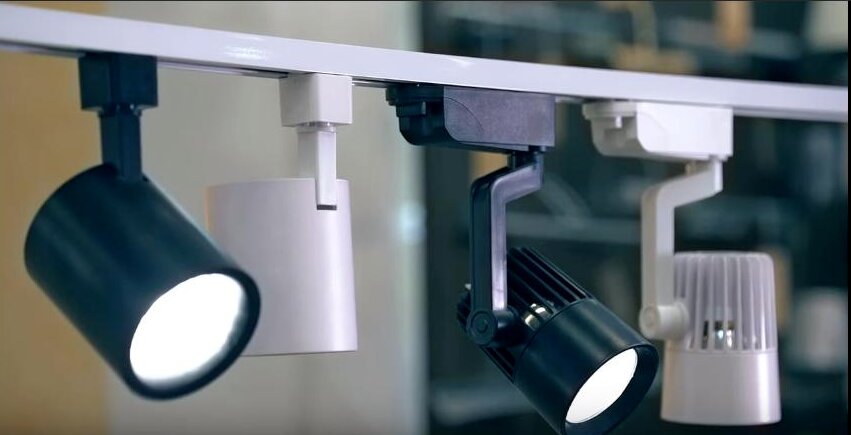
Any track lighting device consists of a track (tire), a lamp. Additional parts: connectors, hangers, brackets, plugs.
Track structure
A track (busbar, frame) is a rail that is mounted to a ceiling or wall with light sources. Busbar body cross-section: rectangular or oval. Distinguish between flexible, rigid frames.

Single and three phase tracks
Inside the profile there are insulated copper busbars for conducting current. There are single-, three-phase bus ducts.
Single-phase track - 2 conductors pass (one phase and zero). All light sources on a single-phase busbar can only be switched on and off simultaneously. This two-wire system is suitable for small cafes, residential apartments.
Three-phase track - 4 conductors pass (three phases and zero). Such a system can be connected to a 220 V, 380 V. If it is planned to connect the track system to a voltage of 380 V, and the lighting devices are designed for 220 V, a converter is additionally connected.
Light sources can be divided into several groups, switched on separately with a two- or three-button switch. Such a four-wire system is suitable for lighting huge areas of shopping centers (reduces the load on the entire network, allows you to configure individual groups of lighting fixtures).
Mini track systems
Mini track systems, which are used as additional lighting, are distinguished separately. Mini constructions consist of 2 chrome-plated copper tubes connected by an insulating profile. Such a frame is powered by 12V. When installing a mini busbar, clips and suspensions are additionally selected.
Magnetic track system

Popular novelties of frame luminaires differ from conventional frames in that different lighting devices are connected to the busbar with magnets. There is a conductive plate with a magnetic core inside the guide profile. Such a magnetic system operates on electricity, but a voltage of 24 or 48 V is required. Additionally, a power supply unit is selected, which is mounted separately, connected via a wire to a copper guide. The power of the power supply unit should be 20-30% higher than the total power of all fixtures of this magnetic track.
Magnetic system advantages:
- easy installation;
- replacement, addition of bulbs to the magnetic frame;
- safety during operation due to low voltage;
- the ability to use under different conditions.
The choice of frame material
The most popular material of the guide frame (track) is aluminum. They also use steel, various alloys, and plastic. When choosing a busbar, take into account the material, the conditions where the structure will be used. The parameter "Dust and moisture resistance" (IP protection class) is important, where the first number indicates the degree of protection against dust, the second - against water. If you plan to install the track system in rooms with a high level of moisture, outdoors, then the IP value should be higher than 45 (for example, IP66 - full protection against dust, protection against strong jets of water).
Standard busbar colors are white, black, gray. Another color or shade of the frame can be ordered for an additional payment directly from the manufacturers or the website of the online store.
Additional elements
Standard frames have a length of 1, 2, 3 and 4 m.Depending on the design of the room, the guide profiles can be shortened (cut to the desired size using a simple hacksaw for metal), connected into different geometric shapes (squares, rectangles, rhombuses) using connectors ( connections). There are several types of connectors:
- Linear connectors - with increasing length (add 35 cm to a 4 m busbar to get a 435 cm busbar).
- Corner joints - when joining the structure at an angle of 90⁰.
- T-shaped - collection of 3 busbars.
- X-shaped connector - combining 4 sections into one system.
- Flexible connections - connections of structures at different heights.
Plugs are placed along the edges of the structure to protect against electric shock, as an element of decor.
How are they attached

There are several ways of attaching frames:
- Suspended - assembled at the bottom (on the floor), additional suspensions (cable) from 1 to 5 m, clamps, fastening brackets, a decorative cap are needed. The distance between the ropes is no more than 1 m, for a uniform load. For high ceilings.
- Overhead - the easiest way, the rail is attached to the ceiling or wall with self-tapping screws, screws every 20 cm. Be sure to calculate the permissible load (1 m of busbar - 5 lamps). For low ceilings.
- built-in - it is worth planning in advance when installing the ceiling, walls, stretch ceilings.
With a significant weight of the structure, reinforcements of internal joints are additionally used.
How to choose light sources
For track lighting, different types of bulbs are used. The choice depends on the place of installation, price, technical characteristics.
Basic types
Before buying light sources, you need to decide on the selection criteria, familiarize yourself with the rating of quality goods, functions (which are), what mistakes they make when buying.
Incandescent bulbs

They consume a large amount of electricity, only 15-20% of the energy is light, 75-80% is used for heating, low cost, but a short term of use. Suitable for living quarters where the light is switched on for a short time (basement, attic, closet, toilet).
There are options where a decorative filament is used. They are used without lampshades and shades as an interesting interior design solution.
Halogen
They differ from ordinary incandescent bulbs in that the tungsten filament is surrounded by an inert gas with halogens (chromium, iodine, bromine). This gas composition increases work (3-4 times longer than conventional lamps) and luminous efficiency (2-4 times).
Allocate finger (designed for 12 V) and linear halogen bulbs (220 V). Linear light sources react to power surges, burn out faster than finger ones. Finger-type ones are used together with current converters (from 220V to 12V), they work longer, and are more expensive than linear ones.
In addition to being sensitive to power surges, halogen lamps get very hot (up to 400-500⁰C). When choosing, take into account the location - you can not install near objects made of flammable materials. An exception is low-voltage lamps, which are designed for 12 V (installed on stretch ceilings). Lighting fixtures are safe thanks to reflectors (70-75% of heat goes down).
Halogen light sources are distinguished by a large selection of glass color of the bulb - green, blue, pink, plain or with patterns, with a mirror coating (gold, silver). There is a large selection of shapes: sphere, mushroom, spiral, candle.
Metal halide lamps (MGL)
MGL consists of 2 capsules - external (nitrogen), internal (mercury, inert gas). When connecting the network, it is additionally necessary to use a ballast (ballast).
Due to the structure, the MGL cannot be dimmed, it takes 4-8 minutes before turning it on again (to cool down), it can explode during power surges, special disposal is required due to mercury, a greenish tint of light appears before the end of work.
High light transmission index (up to 95%), luminous flux stability, wide power range, long service life (up to 15,000 hours) allow the use of MGL on a par with LED counterparts.
Metal halide bulbs are used:
- with continuous, bright illumination of streets, houses, stadiums;
- for trade warehouses, illumination of jewelry store windows;
- during construction (dark time of the day).
Fluorescent (fluorescent lamps)
They are a sealed glass tube with an inert gas (argon). The inner side of the tube is coated with a thin layer of phosphor, which causes a glow. Mercury (10 mg-1 g) is located in the sealed tube of the light source, when heated it turns into mercury vapor. Therefore, disposal is carried out by special certified organizations.
The luminescence power of fluorescent lighting fixtures is higher than that of conventional incandescent bulbs (4-6 times). The service life with the launch mechanism is from 2,000 to 18,000 hours.
There are several categories of fluorescent lamps (depending on the glow temperature):
- soft - up to 2700 K;
- daily - 2700-4200 K;
- cold - 4200-6400 K.
Luminescent ones are marked with 2-3 capital letters. Russian manufacturers use the following designations:
- L - luminescent;
- D - daytime;
- B - white;
- HB - cold white;
- TB - warm white;
- E - natural white;
- G, F, Z, K - blue, yellow, green, red;
- UV - ultraviolet;
- Ts - improved color rendering;
- CC - high quality color rendering.
They also use letters that characterize design features;
- B - quick start;
- K - annular;
- R - reflex;
- Y - y-shaped.
The power of the light sources is shown by the numbers after the letters.
Foreign manufacturers mark fluorescent lamps with numbers - power values (W) / color rendering index (the first digit, you need to multiply by 10), color temperature (K, divide by 100).
Disadvantages - size, dependence on ambient temperature, special disposal requirements. Advantages - fluorescent devices work for a long time, consume little electricity, and give more light. They are used for lighting apartments, country houses, streets, greenhouses, greenhouses.

LED lamps (LED)
The most modern lighting fixtures. Light is emitted when a current is passed through the pn junction (the boundary between 2 semiconductors with different conductivity).
Consist of several LEDs with a power supply in one housing. Heat transfer, uniform light distribution depends on the number of LEDs. There are several types of LEDs:
- DIP and Superflux (Spider) - LEDs with a low luminous flux (indicator light, displays);
- SMD is the most common type of LED that is placed on the board surface. The dimensions of the LED are indicated by 4 digits after the letter designation;
- COB is the most advanced technology for placing a chip on a board. It is characterized by a uniform luminous flux, improved heat dissipation, and reliability of the entire device.
When supplying a stable current to the LED matrix, 2 driver designs are used:
- RC - an inexpensive current source with poor stabilization, suitable for a matrix up to 7 W, power grids without voltage surges;
- IC is a modern driver that neutralizes power surges, suitable for matrices from 170 to 240 W.
The body of LED spots and lanterns is made of ceramics and thermoplastics.
The type of cap (fixing the lamp to the socket) also affects the selection. Distinguish between threaded, pin plinths:
- Threaded caps (Edison) are designated by the letter E. The number after the letter designation indicates the diameter of the cap (mm). They are characteristic of ordinary incandescent bulbs.
- Pin bases are designated with the letter G. The number after the letter is the distance between the contacts (mm). The GU marking indicates the bulge at the end of the pins. Typical for halogen, fluorescent lighting fixtures.
The recessed base contact is designated by the letter R. It is used for linear halogen floodlights.
LED bulbs are available with different types of base (E, G), you can easily replace any lighting elements with economical ones.
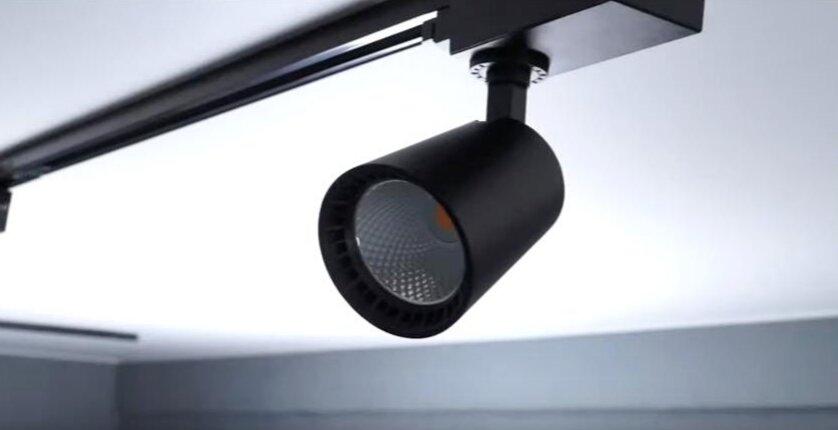
When choosing LEDs, you should additionally pay attention to:
- power (or equivalent power - 6 W shines like a regular 60 W);
- luminous flux (brightness - to replace 60 W you need with an indicator of 600 lm);
- color temperature (2700 K - warm yellow light, 3500-4000 K - office premises, more than 5000 K - utility rooms);
- color rendering index - shows the richness of shades (living quarters more than 80 Ra);
- the presence of a dimmer - brightness control;
- lighting angle (diffuse or local);
- term of work, quality certificate, guarantee.
Main technical characteristics of different lighting devices
| Specifications | incandescent lamp | halogen | luminescent | metal halide | LED |
|---|---|---|---|---|---|
| luminous efficiency, Lm / W | 4-12 Lm / W | 15-17 | 50-75 | 75-95 | 80-115 |
| color temperature, K | 2.680-2.700 | 2.700-3.000 | 2.000-6.500 | 2.000-6.500 | 2.000-6.500 |
| color rendering index, Ra | 80-100 | 90-100 | 80-90 | 55-90 | 80-100 |
| Efficiency,% | 50-70 | 50-80 | 45-75 | 50-75 | 70-100 |
| special disposal | not required | not required | required | required | not required |
| heat generation | high | high | low | low | low |
| service life, hour. | 1,000 hours | 1.500-3.000 | 8.000-12.000 | 6.500-15.000 | 50.000 |
| average cost, rub. | low, 10-20 | low, 70-90 | average | high, 650-1500 | high |
LED bulbs come in various shapes: bulb, pear, candle, spot lamps. The design uses lenses, reflectors to increase the luminous flux.
Positive features of LED light sources:
- long term of work (10.000-60.000 hours);
- work at -60⁰ and + 60⁰;
- low electricity consumption;
- work at different voltages;
- available with different types of plinths;
- resistance to mechanical shock, vibration.
Disadvantages:
- high price;
- cannot be used at high humidity and temperature (baths, saunas).
How to choose

When choosing a frame structure, you need to consider:
- busbar type;
- number of light sources, type of base;
- type of lighting fixtures;
- luminous flux, lighting intensity;
- quality of materials (moisture resistance);
- voltage (220 or 12V);
- power;
- design.
To avoid mistakes when buying frame lighting fixtures, you should heed the advice of experienced specialists:
- choose with a uniform light spot without dark spots, areola;
- value 80-90 Ra (true color) of the light transmission index;
- accentuation of objects (scattering angle 24⁰);
- lighting the space - a spotlight with a wide angle (90-160⁰);
- choose the shape of the shade, the presence of a flexible leg or a turntable;
- install the structure yourself, if you have experience;
- analyze the assortment (selection by price);
- check quality certificates.
Top 10 track lights for 2020
Domestic and foreign manufacturers offer a wide range of quality certified products. The top ranking of popular models shows high-quality lamps, online stores with different prices.
10th place Nowodvorski Profile Iris 9007 LED Track Light
Manufacturer: Poland (Nowodvorski), the model has a laconic black cylinder shape. Product parameters: 130 mm - height and 135 mm - width. Ceiling mount recommended (shops, apartments).
The light source consists of 1 LED bulb with a power of 20 W, color temperature - 4000 K, luminous flux - 1360 lm, voltage - 230 V.
- service life 30,000 hours;
- 2 year warranty;
- there are lighting fixtures included.
- high price.
9th place Rzb 741626.262.79 70W G8,5 track spot
Track spot made in Germany in white. Product parameters: 20 cm - length, 13 cm - width. Recommended for indoor accent lighting.
Metal halide MGL, power 70 W, color temperature - 3000 K, designed for voltage 220 V. Base type - G 8.5.
- economical;
- high color temperature;
- service life up to 15,000 hours.
- price;
- special disposal conditions are required.
8th place TR1 - 30 BK Track Light ERA 30W black COB (10/160)
Russian brand ERA with COB LEDs, scattering angle 24⁰. Made of black aluminum, non-combustible plastic, acrylic. For basic, accent lighting of residential, office, retail and exhibition premises.
LED lamp with a power of 30 W, provides a luminous flux of 2100 lm, a color temperature of 4000 K. Suitable for a voltage of 220 V. Service life - 30,000 hours.
- easy installation to any surface at different stages;
- warranty availability - 2 years;
- long term of work;
- price (in comparison with analogues of foreign manufacturers).
- not identified.
7th place Track light ARTE LAMP RAILS A3056PL-6WH
Production - Italy. Consists of 6 lamps (E14), total power 240 W. Busbar length - 300 cm, width - 11 cm. Metal frame, white shades.
Construction weight - 3.6 kg.
- attractive design;
- long service life.
- high price;
- weight of the structure.
6th place White track lamp Arte lamp A4107PL-1WH TRACK
Production - Italy. Consists of 1 lamp, 7W. Luminous flux - 600 lm, base type - LED, service life - 25,000 hours. The lantern is made of aluminum, white silicone.
- Term of the work;
- warranty - 2 years;
- economical.
- price.
5th place Track light 8090 White
Manufactured by the German company Raumberg. Color - matt white, material - aluminum. Suitable for halogen, 50W LED lamps, GU10 base.
Recommended to be installed on a 1-phase bus in residential apartments, hotels, offices.
- suitable for different types of lighting fixtures;
- economical;
- attractive design.
- lighting devices are not included in the kit, you need to purchase additionally.
4th place Single-phase track lamp AM181 BK 3000K black from IMPERIUMLOFT
Popular manufacturer from China (Amgroup). Made of black metal. There is a 30 W LED light bulb, color temperature - 3000 K, base type - LED.
- low price;
- design;
- profitability;
- warranty - 12 months.
- not identified.
3rd place ULB-Q275 25W-4000K WHITE
Production - Russia (TM Volpe). Lighting device - white spotlight, material - aluminum, plastic. Characteristics of LED bulbs: power 25 W, luminous flux 2200 lm, color temperature 4000 K.
- profitability;
- price;
- warranty - 24 months.
- not found.
2nd place Track LED lamp NOVOTECH UNION 357839
Manufactured by NOVOTECH (Hungary). Spotlight in black aluminum, techno style. Designed for 1 LED lamp, 10 V, color temperature 3000 K, diffusion angle 30⁰. Busbar length - 250 mm, width - 75 mm, weight - 0.66 kg.
Base type - built-in module (LED).
- low price;
- profitability;
- simple installation and operation.
- base - built-in module.
1st place LED track light SLV 3Ph Profuno 152551
Made by the German brand SLV. The busbar is made of white aluminum, the white casing is made of metal. The shape of the lamp is square. Dimensions: width - 155 mm, height - 156 mm.
Recommended to be installed on the ceiling, offices with an area of 9-10 sq.m.
LED bulb included, LED base, power 18 W, luminous flux 960 lm, color temperature 3000 K.
- modern design;
- compact size;
- profitability;
- the presence of a switch / dimmer;
- warranty - 18 months.
- high price.
Output
Frame lighting fixtures are now popular for their merits. The development of digital technologies (built-in motion sensors, measurement of temperature, room illumination, the use of Bluetooth to control lighting devices), care for the environment leads to an expansion of the range, a decrease in the price of energy-saving light sources.
new entries
Categories
Useful
Popular articles
-

Top rating of the best and inexpensive scooters up to 50 cubic meters in 2020
Views: 97661 -

Rating of the best materials for noise insulation for an apartment in 2020
Views: 95022 -

Rating of cheap analogues of expensive drugs for flu and colds for 2020
Views: 91751 -

The best men's running shoes in 2020
Views: 87681 -

Top ranking of the best smartwatches 2020 - price-quality
Views: 85091 -

Best Complex Vitamins in 2020
Views: 84801 -

The best dye for gray hair - 2020 top ranking
Views: 82406 -

Rating of the best wood paints for interior use in 2020
Views: 77202 -

Ranking of the best action cameras from China in 2020
Views: 75269 -

Rating of the best spinning reels in 2020
Views: 74827 -

The most effective calcium supplements for adults and children in 2020
Views: 72463 -

Top rating of the best means for male potency in 2020 with a description
Views: 68296



